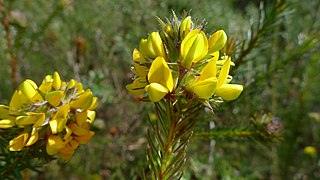
Pultenaea scabra, commonly known as rough bush-pea, is a species of flowering plant in the family Fabaceae and is endemic to south-eastern continental Australia. It is an erect or spreading shrub with hairy stems, heart-shaped leaves with the narrower end towards the base, and yellow and red, pea-like flowers.

Pultenaea flexilis known as the graceful bush-pea, is a species of flowering plant in the family Fabaceae and is endemic to eastern Australia. It is an erect shrub with linear to narrow egg-shaped leaves with the narrower end towards the base, and yellow to orange flowers with red markings.

Pultenaea stipularis, commonly known as handsome bush-pea, is a species of flowering plant in the family Fabaceae and is endemic to New South Wales. It is an erect shrub with glabrous stems, linear to narrow elliptic leaves, and yellow to orange flowers, sometimes with red markings.

Pultenaea blakelyi, commonly known as Blakely's bush-pea, is a species of flowering plant in the family Fabaceae and is endemic to south-eastern continental Australia. It is an erect shrub with sharply-pointed, narrow elliptic to egg-shaped leaves and yellow to orange flowers in open clusters in leaf axils or at the ends of branches.

Pultenaea cuneata is a species of flowering plant in the family Fabaceae and is endemic to eastern Australia. It is an erect shrub with triangular to egg-shaped leaves with the narrower end towards the base, and groups of yellow to orange and red to purple flowers.

Pultenaea dargilensis is a species of flowering plant in the family Fabaceae and is endemic to a small area in central Victoria, Australia. It is a leaning or low-lying shrub with narrow elliptic to lance-shaped leaves and yellow flowers usually arranged singly on the ends of branchlets.

Pultenaea dentata, commonly known as clustered bush-pea, is a species of flowering plant in the family Fabaceae and is endemic to south-eastern Australia. It is an erect to low-lying or prostrate, open shrub with elliptic to narrow egg-shaped leaves and dense clusters of yellow, red and purple flowers.

Pultenaea ferruginea, commonly known as large bronze bush-pea, is a species of flowering plant in the family Fabaceae and is endemic to eastern Australia. It is an erect shrub with hairy stems, narrow egg-shaped leaves with the narrower end towards the base, and yellow to reddish-orange flowers with reddish-brown markings.

Pultenaea foliolosa, commonly known as the small-leaf bush-pea, is a species of flowering plant in the family Fabaceae and is endemic to eastern Australia. It is an erect to low-lying shrub with elliptic to oblong leaves that are concave on the upper surface, and yellow to orange and reddish-brown flowers.

Pultenaea glabra, commonly known as smooth bush-pea, is a species of flowering plant in the family Fabaceae and is endemic to eastern New South Wales. It is an erect shrub with glabrous stems, linear to egg-shaped leaves with a concave upper surface, and yellow to red and orange flowers.

Pultenaea hispidula, commonly known as rusty bush-pea, is a species of flowering plant in the family Fabaceae and is endemic to south-eastern continental Australia. It is an erect, spreading shrub with many drooping branches, oblong to egg-shaped leaves with the narrower end towards the base, and yellow to pale orange and red flowers.
Bossiaea dasycarpa is a species of flowering plant in the family Fabaceae and is endemic to a small area in eastern Australia. It is a prostrate or low-lying shrub with narrow oblong to narrow elliptic leaves, and yellow and red flowers.
Pultenaea lapidosa is a species of flowering plant in the family Fabaceae and is endemic to south-eastern Australia. It is an erect to low-lying shrub with linear to narrow elliptic leaves and deep orange and dark red flowers.

Pultenaea largiflorens, commonly known as twiggy bush-pea, is a species of flowering plant in the family Fabaceae and is endemic to south-eastern continental Australia. It is a rigid, erect shrub with narrow egg-shaped leaves with the narrower end towards the base, and bright yellow and crimson flowers.

Pultenaea laxiflora, commonly known as loose-flower bush-pea, is a species of flowering plant in the family Fabaceae and is endemic to south-eastern continental Australia. It is a low-lying to prostrate, spreading shrub with linear to narrow egg-shaped leaves with the narrower end towards the base, and yellow and red to brown or purple flowers.

Pultenaea linophylla, commonly known as halo bush-pea, is a species of flowering plant in the family Fabaceae and is endemic to south-eastern continental Australia. It is an erect or prostrate shrub with spreading branches, linear to elliptic or wedge-shaped leaves, and yellow to orange and red to purple flowers.

Pultenaea microphylla is a species of flowering plant in the family Fabaceae and is endemic to eastern Australia. It is an erect to prostrate shrub with narrow egg-shaped leaves with the narrower end towards the base, and clusters of up to ten yellow to red flowers with reddish markings.

Pultenaea paleacea, commonly known as chaffy bush-pea, is a species of flowering plant in the family Fabaceae and is endemic to eastern Australia. It is a prostrate to spreading shrub with linear to lance-shaped leaves with the narrower end towards the base, and yellow to orange and red to purple flowers.

Pultenaea parviflora, sommonly known as Sydney bush-pea, is a species of flowering plant in the family Fabaceae and is endemic to eastern New South Wales. It is usually a small, erect shrub with wedge-shaped to narrow egg-shaped leaves with the narrower end towards the base, and clusters of yellow to orange and red flowers.

Pultenaea retusa, commonly known as notched bush-pea, is a species of flowering plant in the family Fabaceae and is endemic to eastern continental Australia. It is an erect shrub with wedge-shaped or egg-shaped leaves with the narrower end towards the base, and yellow to orange and red to purple flowers.



















